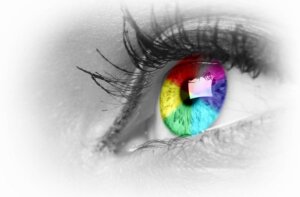Tetrachromats See Life in 100 Million Colors


Written and verified by the psychologist Valeria Sabater
Concetta Antico is an art teacher. One day, she realized something unusual and amazing at the same time: she possesses extraordinary vision. When she asked her students to paint different nature scenes, they captured reality in a more limited way than the way in which she perceived it. In fact, her retinas can distinguish between colors that are invisible to the vast majority.
When this Australian artist walks down a path of small pebbles that most of us see in gray tones, she appreciates a whole symphony of colors. The stones shimmer in mesmerizing shades, ranging from pink to violet, yellow to silver. Indeed, the world that this woman sees daily is like a fascinating chromatic kaleidoscope.
Her skill has allowed her to become a well-known painter as well as giving her a reason to be interested in science. She’s a tetrachromat. She has a singular genetic mutation that allows her to see the world in more than 100 million colors, the same ones that she captures in her overwhelming canvases.
“Going to a grocery store can be very stressful for me because of the mountain of colors that appear from all angles.”
-Concetta Antico-

What are tetrachromats?
Most of us are trichromats. This means we have three types of cones in our retinas. Thanks to them, we can see close to a million colors. However, tetrachromats have four types of cones that allow them to see the world in about 100 million shades. The difference is substantial.
Although we’ve all heard of color blindness and you probably even know someone who has difficulty discriminating colors, tetrachromacy isn’t as well known. That said, we know that a significant part of the population experiences it. It’s also common in the animal kingdom.
Research conducted by Princeton University (USA) has discovered that hummingbirds, like many other birds, can also discriminate non-spectral colors. These are shades that can only be seen with four types of cones. This faculty allows them to search for food more easily. However, what about humans?
Scientists tell us that there are more tetrachromats than we think, to the point that it may be one more inherent characteristic of the human being.
How we see color
What if we were to tell you that color doesn’t exist? It’s true. In nature and everything that surrounds us, there’s no color. It’s our brains that generate this perception. They do so when the retinas of our eyes are stimulated by light radiation and different electromagnetic waves.
Therefore, the trees aren’t green, your jeans aren’t blue, and Superman’s cape isn’t red. What exists is light and what creates color is your brain. It’s one of the greatest neurological peculiarities.
The key lies in the cones
As humans, we have two types of photoreceptors in our retinas: rods and cones. As we’ve already mentioned, the main peculiarity of tetrachromats is that, instead of having three types of cones, they present one more. This genetic peculiarity appears more frequently in people with two X chromosomes, in other words, in women.
The fourth cone allows tetrachromats to capture all the existing tonalities that are contained between the zone of red and standard green. While most of us often can’t tell one shade of yellow from another, they can appreciate hundreds of shades of yellow, for example.
There are a wide range of tonalities that can only be appreciated by birds, fish, and some reptiles thanks to their four types of cones. In humans, many people possess this faculty without even knowing it.
Could you be a tetrachromat?
If you’re interested in this topic, there’s a research paper entitled Human Color Vision and Tetrachromacy (2020). We don’t currently know exactly how many of the general population possess this genetic characteristic. However, it’s estimated that, in the case of women, it could range between 12 and 50 percent. In men, it’s thought to be around eight percent.
As a matter of fact, many people can be tetrachromats and not know it. Indeed, they could be born with this visual peculiarity and assume that everyone perceives the world in the same way. They only realize this nuance when they compare with someone else how they perceive the tonality of certain settings, shades of clothing, colors of the sky, sparkles in the water, bird plumage, etc.
These are the kinds of conversations in which one person points out that the sea has shades that range between cyan, turquoise, and indigo, and the other person claims skeptically, that they only see the classic sea blue.

Stimulate your vision and discover if you’re a tetrachromat
Experts suggest that tetrachromacy is more common than we might think. However, whoever possesses this ability may not be aware of it. Just think of Concetta Antico. When she found out about her visual ability it was during a class with her students. She saw certain shades that the students couldn’t.
A person in the art profession is in contact with the stimulus, sensation, and light radiation of every setting. They train to see the world in a broader way. This makes it easy for them to discover tetrachromacy. However, we can all achieve the same ability if we educate this special sense.
Try walking through natural environments at different times of the day. Appreciate sunrises and sunsets in the mountains or by the sea with their extraordinarily different tonalities. Look at the night sky, the brightness of the stars, and the full moon.
Who knows? You may start to see the world in a richer and more extraordinary way.
All cited sources were thoroughly reviewed by our team to ensure their quality, reliability, currency, and validity. The bibliography of this article was considered reliable and of academic or scientific accuracy.
- Jameson, K., Satalich, T., Joe, K., Bochko, V., Atilano, S., & Kenney, M. (2020). Human Color Vision and Tetrachromacy (Elements in Perception). Cambridge: Cambridge University Press. doi:10.1017/9781108663977
- Stoddard MC, Eyster HN, Hogan BG, Morris DH, Soucy ER, Inouye DW. Wild hummingbirds discriminate nonspectral colors. Proc Natl Acad Sci U S A. 2020 Jun 30;117(26):15112-15122. doi: 10.1073/pnas.1919377117. Epub 2020 Jun 15. PMID: 32541035; PMCID: PMC7334476.
This text is provided for informational purposes only and does not replace consultation with a professional. If in doubt, consult your specialist.








